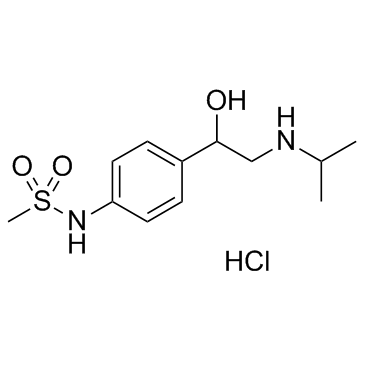Sotalol hydrochloride

Sotalol hydrochloride structure
|
Common Name | Sotalol hydrochloride | ||
|---|---|---|---|---|
| CAS Number | 959-24-0 | Molecular Weight | 308.825 | |
| Density | N/A | Boiling Point | 443.3ºC at 760 mmHg | |
| Molecular Formula | C12H21ClN2O3S | Melting Point | 218-220°C | |
| MSDS | Chinese USA | Flash Point | 221.9ºC | |
| Symbol |

GHS07 |
Signal Word | Warning | |
Use of Sotalol hydrochlorideSotalol Hydrochloride is an adrenergic beta-antagonist that is used in the treatment of life-threatening arrhythmias.Target: Adrenergic ReceptorSotalol is a non-selective competitive β-adrenergic receptor blocker that also exhibits Class III antiarrhythmic properties by its inhibition of potassium channels. Sotalol is a competitive beta adrenoceptor antagonist devoid of membrane-stabilizing activity and intrinsic sympathomimetic activity that has no preferential actions on beta 1 or beta 2 responses. Sotalol causes concentration-dependent increases in the contractility of isolated ventricular tissue that is not blocked by previous beta or alpha blockade or catecholamine depletion. Sotalol consistently reduces the heart rate to a greater degree than propranolol and causes significantly less cardiac suppression than propranolol at a given heart rate [1]. Sotalol is not only a beta blocker but a class III antiarrhythmic drug. Its possible antifibrillatory activity was therefore investigated in both the ventricles and atria of dog heart in situ, since vulnerability to fibrillation is not the same in both these parts of the myocardium [2]. |
| Name | sotalol hydrochloride |
|---|---|
| Synonym | More Synonyms |
| Description | Sotalol Hydrochloride is an adrenergic beta-antagonist that is used in the treatment of life-threatening arrhythmias.Target: Adrenergic ReceptorSotalol is a non-selective competitive β-adrenergic receptor blocker that also exhibits Class III antiarrhythmic properties by its inhibition of potassium channels. Sotalol is a competitive beta adrenoceptor antagonist devoid of membrane-stabilizing activity and intrinsic sympathomimetic activity that has no preferential actions on beta 1 or beta 2 responses. Sotalol causes concentration-dependent increases in the contractility of isolated ventricular tissue that is not blocked by previous beta or alpha blockade or catecholamine depletion. Sotalol consistently reduces the heart rate to a greater degree than propranolol and causes significantly less cardiac suppression than propranolol at a given heart rate [1]. Sotalol is not only a beta blocker but a class III antiarrhythmic drug. Its possible antifibrillatory activity was therefore investigated in both the ventricles and atria of dog heart in situ, since vulnerability to fibrillation is not the same in both these parts of the myocardium [2]. |
|---|---|
| Related Catalog | |
| References |
| Boiling Point | 443.3ºC at 760 mmHg |
|---|---|
| Melting Point | 218-220°C |
| Molecular Formula | C12H21ClN2O3S |
| Molecular Weight | 308.825 |
| Flash Point | 221.9ºC |
| Exact Mass | 308.096130 |
| PSA | 86.81000 |
| LogP | 3.43620 |
| Water Solubility | H2O: 20 mg/mL |
CHEMICAL IDENTIFICATION
HEALTH HAZARD DATAACUTE TOXICITY DATA
|
| Symbol |

GHS07 |
|---|---|
| Signal Word | Warning |
| Hazard Statements | H315-H319-H335 |
| Precautionary Statements | P261-P305 + P351 + P338 |
| Personal Protective Equipment | dust mask type N95 (US);Eyeshields;Gloves |
| Hazard Codes | Xi:Irritant; |
| Risk Phrases | R36/37/38 |
| Safety Phrases | S26-S36 |
| RIDADR | NONH for all modes of transport |
| WGK Germany | 3 |
| RTECS | PB0826000 |
| HS Code | 2942000000 |
| HS Code | 2935009090 |
|---|---|
| Summary | 2935009090 other sulphonamides VAT:17.0% Tax rebate rate:9.0% Supervision conditions:none MFN tariff:6.5% General tariff:35.0% |
|
A pharmacologically validated, high-capacity, functional thallium flux assay for the human Ether-à-go-go related gene potassium channel.
Assay Drug Dev. Technol. 8 , 714-26, (2010) The voltage-gated potassium channel, human Ether-à-go-go related gene (hERG), represents the molecular component of IKr, one of the potassium currents involved in cardiac action potential repolarizati... |
|
|
Resting heart rate and physical activity as risk factors for lone atrial fibrillation: a prospective study of 309,540 men and women.
Heart 99(23) , 1755-60, (2013) To study the impact of resting heart rate and leisure time physical activity at middle age on long term risk of drug treated lone atrial fibrillation (AF).Longitudinal cohort study of 309 540 Norwegia... |
|
|
Antiarrhythmic drug use in patients <65 years with atrial fibrillation and without structural heart disease.
Am. J. Cardiol. 115(3) , 316-22, (2015) Little is known in clinical practice about antiarrhythmic drug (AAD) use in patients with atrial fibrillation (AF) (particularly younger ones) who do not have structural heart disease. Using the Marke... |
| MFCD00242937 |
| Sotacor |
| Sotalol hydrochloride |
| Betapace |
| (±)-Sotalol hydrochloride |
| N-(4-{1-Hydroxy-2-[(1-methylethyl)amino]ethyl}phenyl)methansulfonamidhydrochlorid |
| EINECS 213-496-0 |
| N-Isopropyl-b-(4-methanesulfonamidophenyl)ethanolamine Hydrochloride |
| Methanesulfonamide, N-[4-[1-hydroxy-2-[(1-methylethyl)amino]ethyl]phenyl]-, hydrochloride (1:1) |
| methanesulfonamide, N-[4-[1-hydroxy-2-[(1-methylethyl)amino]ethyl]phenyl]-, monohydrochloride |
| N-Isopropyl-β-(4-methanesulfonamidophenyl)ethanolamine hydrochloride |
| 4'-[1-Hydroxy-2-(isopropylamino)ethyl]methanesulfonanilide monohydrochloride |
| b-Cardone |
| N-{4-[1-Hydroxy-2-(isopropylamino)ethyl]phenyl}methanesulfonamide hydrochloride (1:1) |
| β-Cardone |
| N-{4-[1-hydroxy-2-(propan-2-ylamino)ethyl]phenyl}methanesulfonamide hydrochloride (1:1) |
| N-(4-(1-Hydroxy-2-((1-methylethyl)amino)ethyl)phenyl)methanesulfonamide Monohydrochloride |
| Sotalol Monohydrochloride |
| 4'-[1-Hydroxy-2-(isopropylamino)ethyl]methanesulfonanilide hydrochloride |
| N-(4-{1-hydroxy-2-[(1-méthyléthyl)amino]éthyl}phényl)méthanesulfonamide chlorhydrate |
| Sotalol (hydrochloride) |

